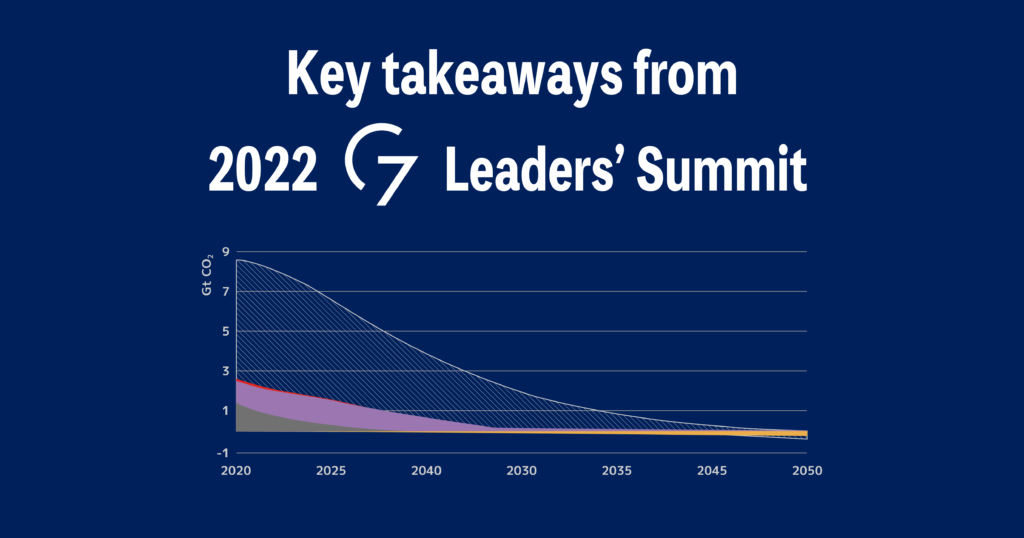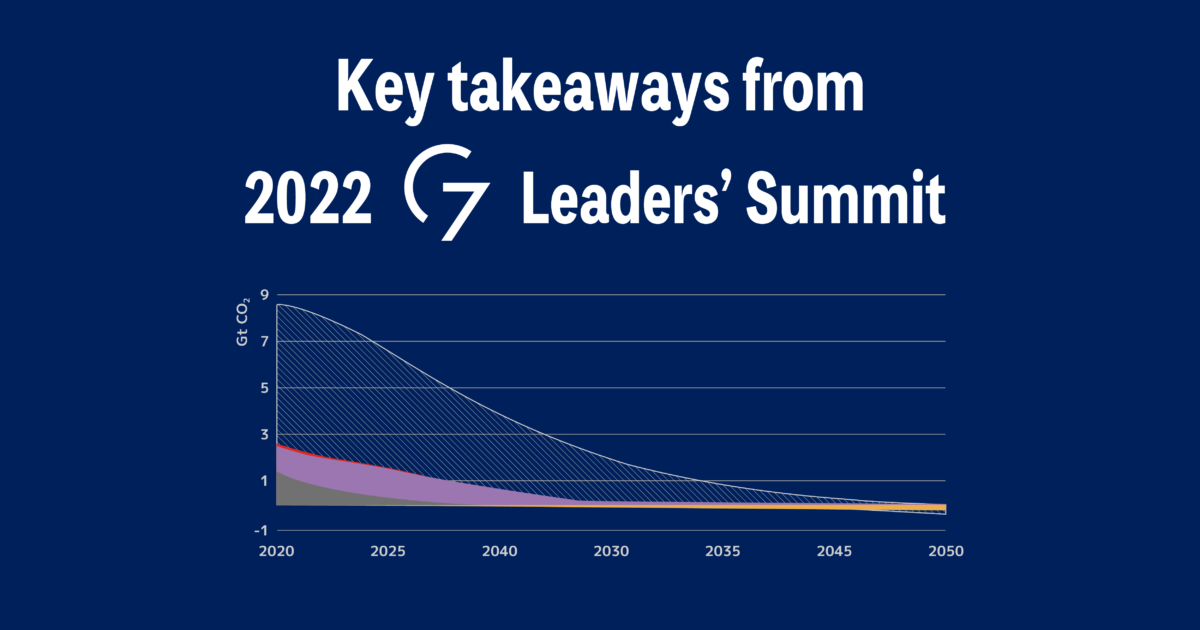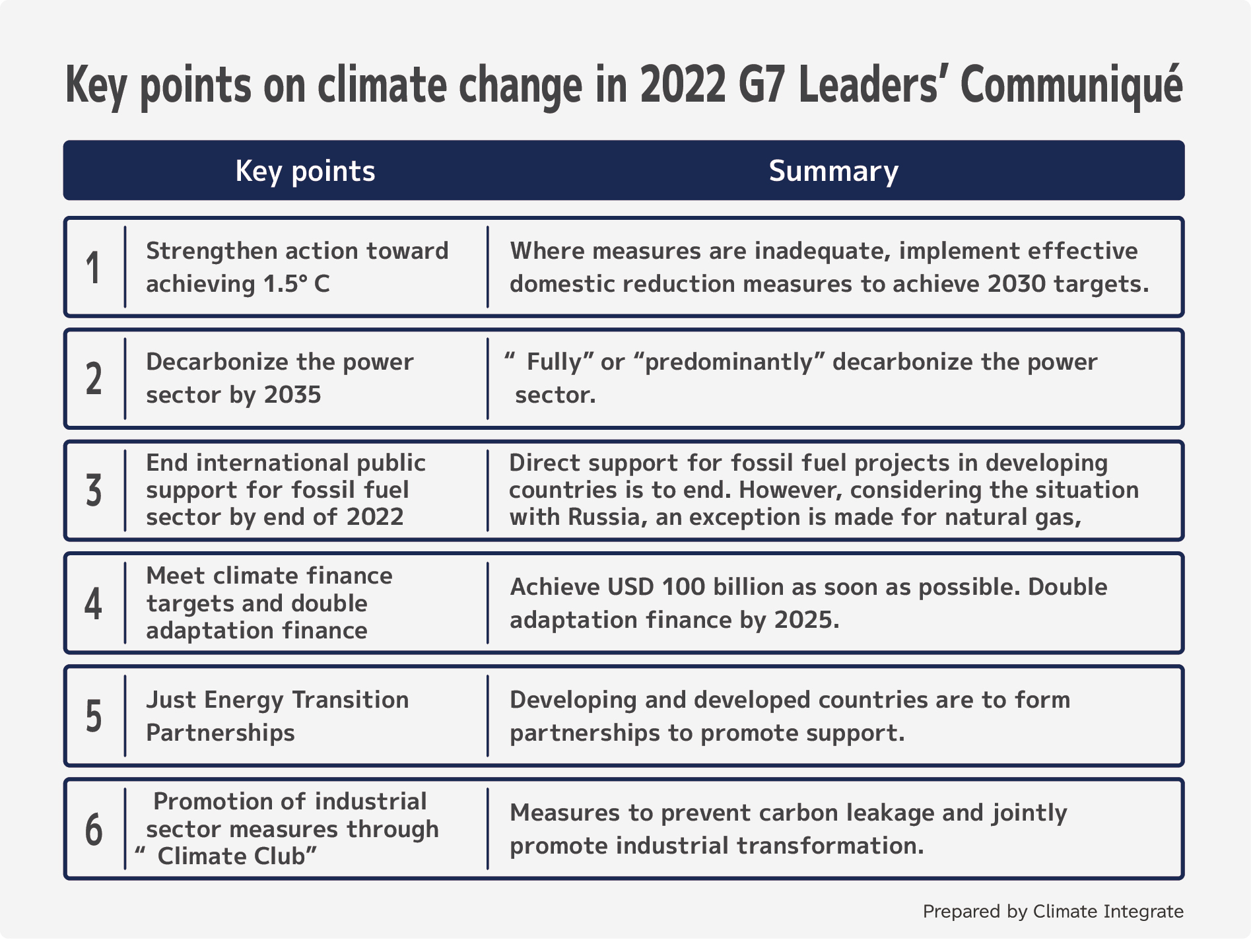
Group of Seven (G7) leaders, during the G7 Summit in June in Elmau, Germany, agreed to find solutions to issues such as climate change, a just transition, COVID-19 and gender equality. The leaders also confirmed their determination not to compromise on climate change and biodiversity targets, and to reduce dependence on Russian energy, despite heightened energy and food risks resulting from Russia’s invasion of Ukraine, according to the G7 Leaders’ Communiqué (“Communiqué”) .
Japan will hold the G7 presidency and host the summit in Hiroshima next year. To help advance climate actions of G7 and beyond, here are our recaps of key agreements on climate change at G7 this year.
Ⅰ. Key points of Communiqué
The Communiqué (original English, Japanese) was put together building on the G7 Climate, Energy and Environment Ministers’ Communiqué (original English, Japanese) from a meeting held May 26 and 27. Key points were as follows.
1. Strengthen efforts to address climate change in order to limit the temperature rise to 1.5°C
Recognizing that current global measures are insufficient to meet the goals of the Paris Agreement, G7 countries committed to effectively implement domestic mitigation (greenhouse gas emission reduction) measures to achieve Nationally Determined Contribution (NDC) targets for 2030, and to increase ambition, including for example, by adopting or strengthening sectoral targets, non-CO2 sub-targets, or stringent implementation measures.
2. Achieve a fully or predominantly decarbonized power sector by 2035, prioritizing a coal phase out
Acknowledging that an energy supply with strong reliance on energy efficiency and renewable energy is economically sensible, technically feasible, reliable and safe, G7 countries committed to achieving a fully or predominantly decarbonized power sector by 2035. In particular, recognizing that coal power generation is the single biggest cause of global temperature increase, G7 countries committed to prioritizing concrete and timely steps towards the goal of accelerating a phase-out of domestic unabated coal power generation. The G7 countries committed to increasing electricity generated by renewable energies in all sectors, to removing barriers and obstacles that currently hinder or slow down the expansion of renewable energies, and to reducing energy consumption.
3. End new direct public support for the international unabated fossil fuel energy sector by the end of 2022
G7 leaders committed to ending new direct public support for the international unabated fossil fuel energy sector by the end of 2022. However, in order to phase out dependency on Russian energy, they acknowledged that as a temporary measure it was appropriate to allow publicly supported investment in the gas sector, if implemented in a manner consistent with climate objectives and without creating lock-in effects.
4. Commitment to deliver on USD 100 billion funding goal ASAP and finance for adaptation
G7 leaders renewed their commitment to deliver on the USD 100 billion climate finance mobilization goal (agreed at a United Nations Framework Convention on Climate Change/COP climate conference) as soon as possible and by 2025. They also renewed the commitment to at least double the provision of climate finance for adaptation to developing countries from 2019 levels by 2025. They recognized the urgent need for scaling-up action and support to avert, minimize, and address loss and damage* particularly in vulnerable developing countries.
* Losses and damages that are already occurring from the impacts of climate change despite adaptation efforts.
5. Support energy transition while supporting a just transition
G7 leaders declared to reduce reliance on fossil fuels and accelerate the clean energy transition, they will support developing countries to make just transitions, through partnerships including Just Energy Transition Partnerships (JETPs), supported by the G7 Partnership for Global Infrastructure and Investment (PGII). Following on support for South Africa announced at UNFCCC/COP26, preparations are under way for JETP-related initiatives in Indonesia, India, Senegal and Vietnam.
6. “Climate Club” will promote decarbonization of the industrial sector
G7 leaders decided to establish an open and cooperative “Climate Club” by the end of 2022. The Climate Club will aim to promote decarbonization of the industrial sector based on three pillars:
(1) Strengthen mechanisms for calculating and reporting emissions, and addressing risks of carbon leakage at the international level
(2) Work collaboratively for industrial transformation to accelerate decarbonization (through the G7 Industrial Decarbonisation Agenda, the G7 Hydrogen Action Pact, expanding the market for green industrial products, etc.)
(3) Strengthen international efforts through partnerships and cooperation to promote a just energy transition, while promoting climate action and generating socioeconomic benefits
Key points of G7 Communiqué
・ Although G7 leadership is far from adequate, the commitment to limit the temperature rise to 1.5°C and to strengthen action, and the commitment to decarbonize the power sector by 2035, with a priority on phasing out coal-fired power generation, will accelerate efforts by G7 countries. This is the first time the G7 has agreed to a phase out of coal-fired power generation.
・ In terms of international support, the G7 has made progress from last year’s commitment to end direct support for coal-fired power generation to this year’s commitment to end direct support for the fossil fuel energy sector as a whole. G7 leaders confirmed that funds to support developing countries need to be increased for both mitigation (measures to reduce emissions) and adaptation (measures to address climate impacts), but no further consensus was reached.
・ Developing and developed countries are forming partnerships to support a just transition. The Climate Club, to promote decarbonization of the industrial sector, is a new move aiming to address the carbon leakage problem through international cooperation. It will be important to monitor its progress.
・ Besides addressing climate change, G7 leaders also committed to conserving or protecting at least 30% of land and 30% of the ocean by 2030, to restoring ecosystems, and to mainstreaming, enhancing, and scaling up the implementation of Nature-based Solutions (NbS).
Ⅱ. Japan’s role
ー and the road to the G7 Hiroshima Summit (2023) ー
1. Japan’s own interpretation
Japan agreed to the Leaders’ Communiqué as a member of the G7, but it is evident that Japan has some of its own interpretations as to what was agreed. Here we look at two terms where Japan’s interpretation differs significantly from that of other G7 countries.
・Predominantly
The Communiqué states that G7 leaders commit to achieving a “fully” or “predominantly” decarbonized power sector by 2035.
The Japanese government translation of the word “predominantly” in this Communiqué is 大宗 (pronounced taiso, which would mean “main” or “majority”). Common alternative translations of “predominantly” include 大部分 (daibubun, mostly) and 圧倒的 (attoteki, overwhelmingly). Although the agreement does not provide specific figures, a G7 power sector decarbonization scenario for net zero in 2050, published in 2021 by the International Energy Agency (IEA), shows coal-fired power generation at zero in 2035, and gas-fired power generation at only 2% (see figure), so that puts non-fossil fuel power generation at 98% in 2035. Thus, the general interpretation of the word predominantly in the G7 Communiqué would be “almost complete decarbonization.”

Figure: G7 energy-related emissions and electricity sector milestones in the Net Zero Emissions by 2050 Scenario (IEA)
Source: IEA report (PowerPoint presentation). Japanese version translated by Climate Integrate.
Conversely, statements at ministerial press conferences and other venues reveal a significant discrepancy between the international community’s concept versus Japan’s interpretation that “predominantly” just means “more than half.”
Tsuyoshi Yamaguchi, then Minister of the Environment: “There is not necessarily a fixed definition of what percentage is meant by ‘predominantly,’ but at least 50% should be acceptable.
“Transcript of Post-Cabinet Meeting Press Conference by Minister Yamaguchi” (May 31, 2022), in Japanese.
Koichi Hagiuda, then Minister of Economy, Trade and Industry: “There is no discrepancy with Japan’s schedule for carbon neutrality .“Summary of Post-Cabinet Meeting Press Conference by Minister Hagiuda” (May 31, 2022), in Japanese.
The ratio of fossil fuels in the 2030 power generation mix under Japan’s Sixth Strategic Energy Plan is 41%, and the plan for 2035 has not yet been formulated. It makes no sense for officials to state that there is no discrepancy between the G7 consensus and Japan’s schedule when there is still no clear picture of how Japan would achieve derarbonization. To be consistent with the Communiqué, Japan would have to reduce thermal power generation before it can decarbonize the power sector.
・Unabated
The Japanese government has translated “unabated coal power generation” as “coal-fired power generation without emission reduction measures”.
The Intergovernmental Panel on Climate Change (IPCC) Sixth Assessment Report by Working Group III (SPM36, April 2022, footnote 55), refers to “unabated“ as being “without interventions that substantially reduce the amount of GHG emitted,” and gives the example of “capturing 90% or more from power plants.” Based on this, a power plant that does not have without carbon capture and storage (CCS) equipment to capture and store 90% of its GHG emissions would not fall under the definition of having “interventions that substantially reduce the amount of GHG emitted.”
Meanwhile, the Japanese government is promoting ammonia co-firing in coal-fired power plants as a so-called “zero-emissions power source,” with a target of 20% co-firing by 2030. In addition, since no coal-fired power plants in Japan are currently equipped with CCUS, it is highly likely that in 2030, there will be no coal-fired power plants in Japan that meet the IPCC’s definition of “interventions that substantially reduce the amount of GHG emitted.” In other words, the Japanese government’s policies are not consistent with the G7 Communiqué. Japan needs to move forward with the domestic phase-out of coal-fired power plants.
2. Looking toward the G7 summit in Hiroshima in 2023
The G7 Summit in 2023 will be held in Hiroshima, under Japan’s presidency. Japan’s role is to step up efforts that are aligned with this year’s G7 Communiqué.
As part of efforts to limit the temperature rise to 1.5°C, a global stock take will be held in 2023 to assess the current level of efforts under the UNFCCC. The G7 must build the stepping stones to get there, to work together to further strengthen and accelerate climate actions, and to achieve stronger commitments.
The Hiroshima G7 Summit will provide an opportunity to think about peace and nuclear issues. This summit will be an important occasion to accelerate climate actions as a crucial element of protecting peace for humanity. We look to the Japanese government, having the presidency of the 2023 G7 Summit, to build on the 2022 Communiqué, and to play a strong leadership role in achieving consensus to accelerate decarbonization of the electric power and other sectors and to expand assistance to developing countries.
Written by Kimiko Hirata, Atsuko Kawaguchi, Chisaki Watanabe


